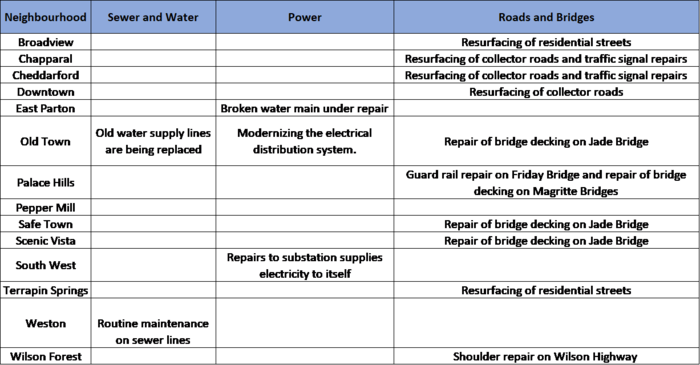Difference between revisions of "IS428 AY2019-20T1 Assign Goh Jia Xian"
(Created page with "Test") |
|||
| Line 1: | Line 1: | ||
| − | + | =Overiew= | |
| + | |||
| + | St. Himark has been hit by an earthquake, leaving officials scrambling to determine the extent of the damage and dispatch limited resources to the areas in most need. They quickly receive seismic readings and use those for an initial deployment but realize they need more information to make sure they have a realistic understanding of the true conditions throughout the city. | ||
| + | |||
| + | In a prescient move of community engagement, the city had released new damage reporting mobile application shortly before the earthquake. This app allows citizens to provide more timely information to the city to help them understand damage and prioritize their response. | ||
| + | |||
| + | |||
| + | =Objective= | ||
| + | |||
| + | With emergency services stretched thin, officials are relying on citizens to provide them with much-needed information about the effects of the quake to help focus recovery efforts. By combining seismic readings of the quake, responses from the app, and background knowledge of the city, help the city triage their efforts for rescue and recovery. | ||
| + | |||
| + | # Emergency responders will base their initial response on the earthquake shake map. Use visual analytics to determine how their response should change based on damage reports from citizens on the ground. How would you prioritize neighbourhoods for response? Which parts of the city are hardest hit? Limit your response to 1000 words and 10 images. | ||
| + | # Use visual analytics to show uncertainty in the data. Compare the reliability of neighbourhood reports. Which neighbourhoods are providing reliable reports? Provide a rationale for your response. Limit your response to 1000 words and 10 images. | ||
| + | # How do conditions change over time? How does uncertainty in change over time? Describe the key changes you see. Limit your response to 500 words and 8 images. | ||
| + | # The data for this challenge can be analyzed either as a static collection or as a dynamic stream of data, as it would occur in a real emergency. Describe how you analyzed the data - as a static collection or a stream. How do you think this choice affected your analysis? Limit your response to 200 words and 3 images. | ||
| + | |||
| + | |||
| + | =Useful information from “St. Himark - About Our City”= | ||
| + | From the description about St. Himark, we can come to gather some useful information about the city’s infrastructure. These are the on-going projects in the following neighbourhoods to improve its infrastructure: | ||
| + | |||
| + | [[Image:Jarrett-On-going Projects.png|700px|center]] | ||
| + | |||
| + | The above-mentioned projects may affect the scores on damages reported by the citizens on the mobile application. | ||
Revision as of 18:57, 13 October 2019
Overiew
St. Himark has been hit by an earthquake, leaving officials scrambling to determine the extent of the damage and dispatch limited resources to the areas in most need. They quickly receive seismic readings and use those for an initial deployment but realize they need more information to make sure they have a realistic understanding of the true conditions throughout the city.
In a prescient move of community engagement, the city had released new damage reporting mobile application shortly before the earthquake. This app allows citizens to provide more timely information to the city to help them understand damage and prioritize their response.
Objective
With emergency services stretched thin, officials are relying on citizens to provide them with much-needed information about the effects of the quake to help focus recovery efforts. By combining seismic readings of the quake, responses from the app, and background knowledge of the city, help the city triage their efforts for rescue and recovery.
- Emergency responders will base their initial response on the earthquake shake map. Use visual analytics to determine how their response should change based on damage reports from citizens on the ground. How would you prioritize neighbourhoods for response? Which parts of the city are hardest hit? Limit your response to 1000 words and 10 images.
- Use visual analytics to show uncertainty in the data. Compare the reliability of neighbourhood reports. Which neighbourhoods are providing reliable reports? Provide a rationale for your response. Limit your response to 1000 words and 10 images.
- How do conditions change over time? How does uncertainty in change over time? Describe the key changes you see. Limit your response to 500 words and 8 images.
- The data for this challenge can be analyzed either as a static collection or as a dynamic stream of data, as it would occur in a real emergency. Describe how you analyzed the data - as a static collection or a stream. How do you think this choice affected your analysis? Limit your response to 200 words and 3 images.
Useful information from “St. Himark - About Our City”
From the description about St. Himark, we can come to gather some useful information about the city’s infrastructure. These are the on-going projects in the following neighbourhoods to improve its infrastructure:
The above-mentioned projects may affect the scores on damages reported by the citizens on the mobile application.
